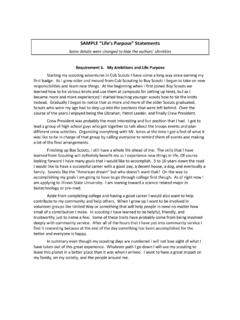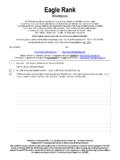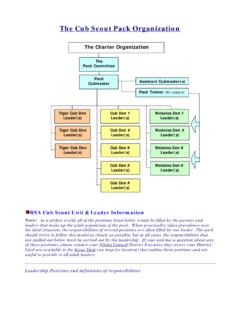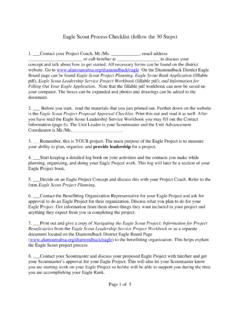Transcription of INTRODUCTION TO LEADERSHIP SKILLS FOR TROOPS
1 INTRODUCTION . TO LEADERSHIP . SKILLS FOR TROOPS . FACILITATOR GUIDE. 2. INTRODUCTION TO LEADERSHIP SKILLS FOR TROOPS . INTRODUCTORY INFORMATION . LEADERSHIP IN SCOUTING. LEADERSHIP is a vital part of the Scouting program. Youth in positions of LEADERSHIP run the troop. They take care of the many tasks necessary for troop and patrol meetings and activities to run smoothly. By accepting the responsibilities of troop LEADERSHIP , Scouts are preparing themselves to be leaders throughout their lives. Activities encountered by a troop's youth leaders might include Assigning responsibility to others Planning, organizing, and leading activities and meetings Planning menus and figuring out food costs Encouraging advancement Guiding a troop's involvement in problem-solving Teaching outdoor, sports, or craft SKILLS Ensuring the troop's safety during meetings and outings Helping other Scouts make the most of their own LEADERSHIP opportunities The badge of office presented to a Scout who is accepting a position of troop LEADERSHIP does not automatically make the Scout a good leader.
2 INTRODUCTORY INFORMATION. 3. INTRODUCTION TO LEADERSHIP SKILLS FOR TROOPS . WHY THIS COURSE? Training youth to be leaders is an ongoing process that begins immediately when a Scout accepts a LEADERSHIP position in the troop. LEADERSHIP experiences can be frustrating and disappointing for a Scout who is not given the knowledge, SKILLS , and encouragement needed to fulfill the LEADERSHIP assignment. It is the Scoutmaster's responsibility to make sure the Scout has all the necessary tools and to coach and mentor the Scout to be successful. The purpose of the INTRODUCTION to LEADERSHIP SKILLS for TROOPS (ILST) course is to teach Scouts with LEADERSHIP positions about their new roles and the organizational and LEADERSHIP SKILLS needed to most effectively reach success in that role.
3 Completion of ILST is a prerequisite for Scouts to participate in the more advanced LEADERSHIP courses National Youth LEADERSHIP Training (NYLT). and the National Advanced Youth LEADERSHIP Experience (NAYLE). It is also required to participate in a Kodiak Challenge Trek. WHO PARTICIPATES IN THIS COURSE? This course is for every Scout in the troop who holds a LEADERSHIP position , including all elected positions and any appointed positions at the discretion of the senior patrol leader. In some TROOPS , this might mean that this course is for every Scout! It is strongly preferred that all Scouts with troop LEADERSHIP positions participate in this course at the start of each term of office, even if they have participated before, and even if they are filling the same LEADERSHIP position .
4 It is beneficial for the Scouts to go through this course together, even if only some of them are new leaders. In some cases, it can benefit the troop if youth who are likely to become troop leaders also participate in the course. Two key purposes of this course are the establishment of personal goals for each youth leader and the effective formation of the LEADERSHIP team. Both of these purposes are best achieved if all Scouts with troop LEADERSHIP positions do this together. In order to keep experienced youth leaders who have been through this course before from becoming bored or perhaps not wanting to participate again, the troop should consider having them serve as trainers for some of the segments or as facilitators for some of the games and challenges in this course.
5 Scouts who have previously graduated from ILST or National Youth LEADERSHIP Training can also be used as trainers or facilitators, especially in Module Two and Module Three. INTRODUCTORY INFORMATION. 4. INTRODUCTION TO LEADERSHIP SKILLS FOR TROOPS . WHEN TO CONDUCT THIS COURSE. The first step in LEADERSHIP training for Scouting youth is orienting the Scouts to the positions they have agreed to fill. That orientation is an important occasion to give new youth leaders the clear message that they have the ability to handle the position , that they are trusted, and that they can get all of the support and guidance they need to succeed. The orientation gives the Scouts an immediate overview of their obligations and opportunities as leaders and sets them on the right foot toward success.
6 In most cases, the Scoutmaster is the one who can most effectively conduct this orientation for the senior patrol leader and other new troop leaders. The Scoutmaster may call on other adults or youth leaders to conduct the orientation for each troop position . The next step in the Scout's training is this course: INTRODUCTION to LEADERSHIP SKILLS for TROOPS (ILST), which provides them with a broader understanding of the troop and ways they can work with other troop leaders (both Scouts and adults) to make the troop a success, and gives them strategies for dealing with many of the challenges they are likely to face. ILST should be conducted shortly after a new term of office begins.
7 If there will be a delay of more than a few weeks between the start of the new term and this course, then the Scoutmaster should conduct a leaders' orientation right after the election of new youth leaders. The length of terms of office varies from troop to troop and even from year to year within a troop. Ultimately, it's up to your troop to determine when to conduct ILST. The ILST program is most constructive when attended by six or more Scouts. If the troop is small and does not have enough Scouts in LEADERSHIP positions for an effective session, work with the troop committee to identify other TROOPS in the area with whom you can organize a training event.
8 Upon completion of INTRODUCTION to LEADERSHIP SKILLS for TROOPS , each participant is qualified to wear the Trained emblem on their uniform. INTRODUCTORY INFORMATION. 5. INTRODUCTION TO LEADERSHIP SKILLS FOR TROOPS . ABOUT THIS COURSE. This ILST guide is meant to offer the Scoutmaster and senior patrol leader a flexible training program for troop leaders. It is not a syllabus to be followed verbatim since every troop is different. Trainers can review the resource material and adapt it to their individual troop's needs. ILST is organized into three modules, each of which should take 60 to 90 minutes to complete, with additional optional games and challenges to enhance the LEADERSHIP lessons (and fun) of the course.
9 MODULE ONE TROOP ORGANIZATION includes a description of each LEADERSHIP position in the troop, including roles and responsibilities, troop organization, and introductions to vision and servant LEADERSHIP .. MODULE TWO TOOLS OF LEADERSHIP covers some core skill sets to help the Scout lead, including communicating, planning, and teaching.. MODULE THREE LEADERSHIP AND TEAMWORK incorporates additional LEADERSHIP tools for the Scout, including discussions of teams and team characteristics, the stages of team development and LEADERSHIP , inclusion/using your team, a more in-depth review of vision, and ethics and values of a leader. INTRODUCTORY INFORMATION.
10 6. INTRODUCTION TO LEADERSHIP SKILLS FOR TROOPS . ILST may be conducted in a variety of ways. Three recommended formats are: Conduct it over three different days, one module at a time, perhaps before three regular troop meetings that incorporate some of the optional games. Conduct it in one session. If this single-day format is used, it is important to include several breaks for two reasons: Without breaks, participants will become overloaded and lose attention. Participants often benefit from being able to immediately spend some time thinking about, discussing, and applying their newly learned LEADERSHIP SKILLS to their positions, perhaps by writing goals or brainstorming about new activity ideas.






